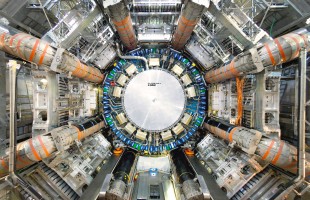Physicists at the ATLAS experiment at CERN are beginning to gain insight into the field that produces the Higgs particle for the first time. This is earlier than previously hoped.
“I feel a bit like living in the future,” says Nikhef researcher Tristan du Pree of ATLAS. With a number of Dutch researchers and PhD students, he was closely involved in the new analysis, which was presented earlier this week on the Italian island of Elba.
Self-interaction
The analysis revolves around the so-called self-interaction of the Higgs particle. From this, the shape of the Higgs field, which allows elementary particles to have mass, can be deduced. This shape is now only known theoretically, and mathematically has the shape of a Mexican hat, but not yet measured in detail.
The existence of the Higgs particle itself was demonstrated at CERN in 2012 and was proof of the presence of a Higgs field.
The self-interaction is measurable in processes where proton-proton collisions in the accelerator create two Higgs particles. Du Pree and colleagues sought clues to di-higgs production via the characteristic production of a pair of bottom quarks and a pair of photons in all data from the LHC accelerator through the record year 2024.
Doubling the data
That roughly doubles the measurement data that could be used for the analyses. This puts statistical significance above 1 sigma for the first time, a measure of the relevance of a result. “It is a first glimpse of the double Higgs production,” he said.
PhD student Eli Sidley (UTwente) and postdoc Luca Franco (RU Nijmegen), among others, had an important role in the new analysis.
The step forward is unexpectedly large due to the increased amount of data and a number of new analysis methods. Previous analyses combined all possible processes leading to higgs-higgs and the significance was half a sigma. The new result is already twice as significant based on a single bb process.
Earlier than thought
The first look at the double higgs processes comes earlier than expected. At CERN, an upgrade of the accelerator to a machine with ten times the intensity, the HL-LHC, is being prepared. Until now, it was assumed that the di-higgs would only come into view toward the end of the measurement period with that accelerator.
Nikhef recently acquired an ENW-XL grant from science financier NWO for the measurements of double-higgs processes. Ten new PhD students and postdocs are currently being recruited for the project. “After finding the higgs itself, this is kind of the holy grail in particle physics,” says Du Pree.

